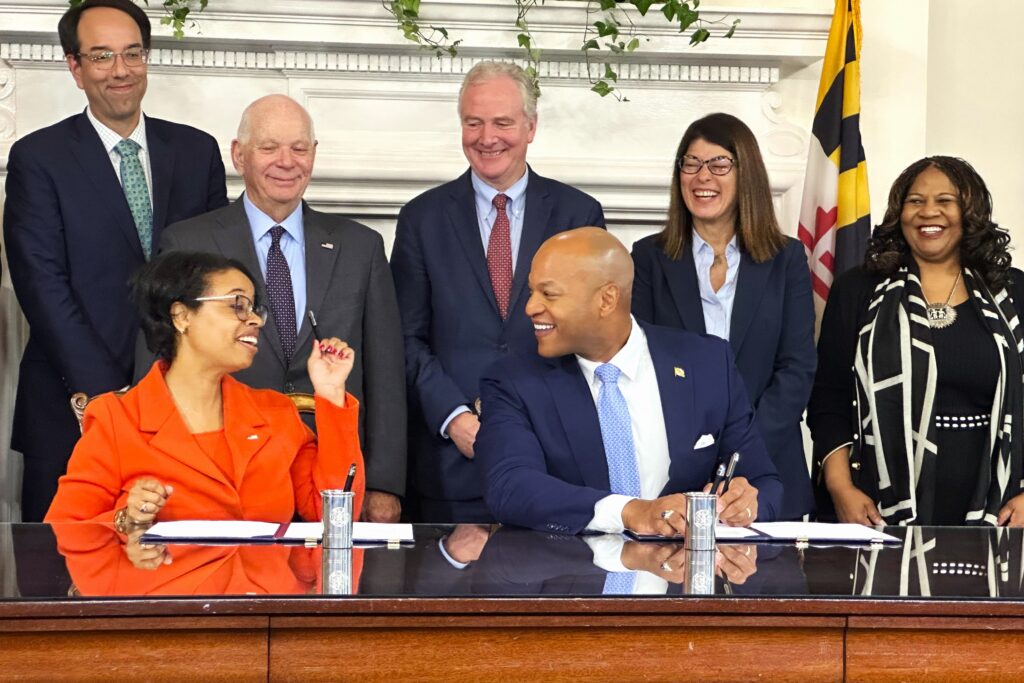
Gov. Wes Moore and CMS Administrator Chiquita Brooks-LaSure, backed by Maryland health officials and the state’s U.S. senators, sign an agreement Friday for Maryland to enter the federal AHEAD model. Photo by Danielle J. Brown.
It’s been in place in one form or another in Maryland for the better part of a decade and it won’t fully kick in for another 14 months, but state and federal officials were still touting Friday’s signing of a formal agreement as a win for patients, providers and the state.
“Many of the elements of the agreement that we will sign today have been directly inspired by how Maryland has approached health for decades,” said Gov. Wes Moore, surrounded by the state’s senators, state and federal officials. He said the agreement with the federal Centers for Medicare and Medicaid Services “will set a new gold standard for how states approach public health.”
“In other words this is a big, big deal,” Moore said.
Maryland was one of the first states, with Vermont, selected by CMS in July to implement the new States Advancing All-Payer Health Equity Approaches and Development — or AHEAD — Model. More states are expected to join the program later.
The federal AHEAD program is modeled on existing programs in Maryland, Vermont and Pennsylvania that are known as total cost of care. Under those programs, states set annual hospital payments in advance, but include patient outcome goals — reducing readmissions, for example — as incentives.
The federal program will require the state to annually meet certain metrics that indicate it has reduced per capita hospital expenditures while ensuring that patients receive quality health care services. States under the AHEAD model will implement a “global budget” for hospitals, which is the total amount of revenue each hospital can earn in a year.
Md. health officials have applied for new federal ‘AHEAD model.’ Here’s what it means.
The agreement signed Friday maintains the state’s flexibility in managing hospital budgets, community health and health equity, while also establishing certain metrics that the state must meet in order to comply with the AHEAD program.
Maryland is already a couple steps ahead: It has had global budgets on hospitals since 2014, and began using total cost of care several years later, both of which are regulated by the state’s Health Services Cost Review Commission.
“Maryland has blazed a trail in tackling health care expenditures,” CMS Administrator Chiquita Brooks-LaSure said at the signing. “You’re already ahead with a current global budget, budget methodology for acute care hospitals and an existing primary care program.
“For Marylanders, the AHEAD model will mean stronger primary care, stronger connections to resources and more coordinated care that supports all of their health-related needs,” she said. “It will mean not getting shuffled around and treated as a diagnosis — but instead be supported and cared for as a person.”
Implementation of the AHEAD Model is not scheduled to kick in until Jan. 1, 2026. The state is currently in a “pre-implementation period” when state officials work with CMS to layout a roadmap for the new plans.
In Friday’s agreement, the state promises to hit certain “accountability targets” to improve population health and increase primary care investments, among other metrics.
Melony Griffith, former state senator and current president of the Maryland Hospital Association, said after the agreement signing that moving into the AHEAD model will “build on work that Maryland has been doing for decades.”
“It’s an opportunity for us to refine the work that we have been doing, enveloping other partners in the health care continuum — to do this important work to provide equitable, high quality health care moving forward,” she said.
Gene Ransom, CEO of MedChi, the state’s medical society, said MedChi’s members appreciate the investment into primary care under the AHEAD Program, but there is a long road ahead.
“We need additional investment in primary care. Primary care is woefully underpaid. So with this dedication and directed resources towards improving that, it could make a big difference for the state,” Ransom said. “But again, we have a lot of other issues that need to be worked out. This is a step in the process.”

